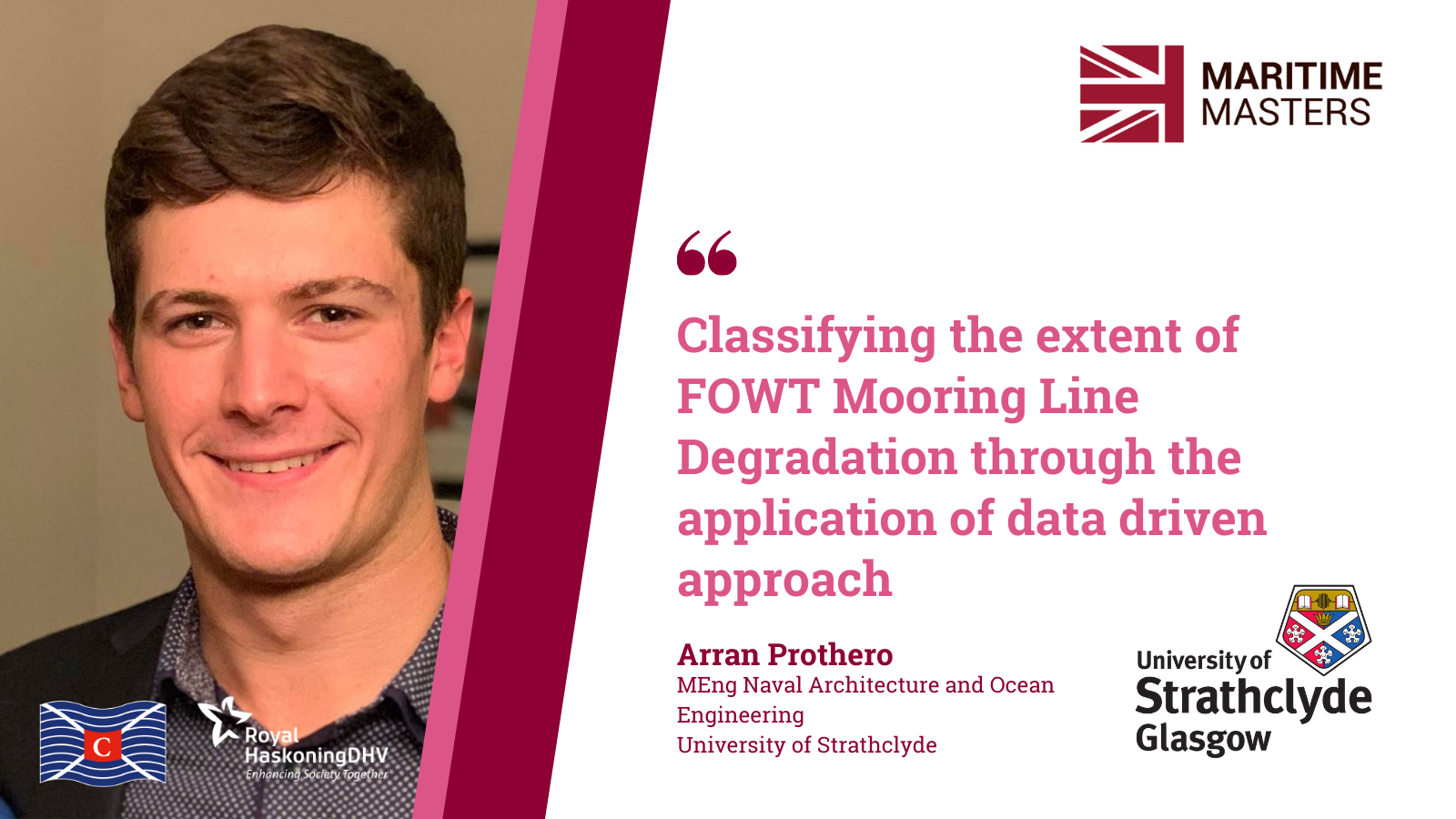Arran Prothero

Biography:
Arran Prothero has completed four out of his five years at Strathclyde University studying for a masters in Naval Architecture and Ocean Engineering. He has held internship positions with Scottish Power Renewables and InterMoor ltd working on offshore renewable projects and hopes to continue in this sector after his university career. As Chairman of the Strathclyde University IMarEST Student Section and member of IEEE OES Arran enjoys staying up to date on all areas of ocean and marine engineering organising and listening to technical lectures delivered in the naval architecture department.
Introduction to research:
Direct line tension monitors, used by the oil industry to estimate the mooring system condition, are uneconomical for the multitude of platforms and moorings required by
floating offshore windfarms (CarbonTrust 2019). These systems need to be more dependable and accurate to reduce the risk associated with remote unmanned platforms (Brown et al. 2005).
Data driven analytics and machine learning methods exhibit the ability to identify and classify outputs of highly non-linear relationships. Administered to the problem of mooring condition estimation this method could increase the reliability of mooring monitoring systems by eliminating direct tension measurement. A risk-based inspection regime reducing operational expenditure (OPEX) could then be implemented on the mooring system.
This project aimed to develop a methodology for analysing the degradation status of a floating offshore wind turbine (FOWT) mooring's without direct tension measurement. 1080 simulations which varied in degradation percentage and environmental condition produced a database of platform and mooring line response information. This database was then used to train and test two Artificial Neural Networks (ANNs). Both ANNs were compared in terms of accuracy, feasibility and cost. The final result showed that the system without mooring response information obtained a classification accuracy of 97%. This shows that the methodology is successful without direct line sensors and has the possibility to reduce the cost of FOWT mooring monitoring whilst still obtaining a high accuracy.
CarbonTrust (2019), Floating wind joint industry project - phase 1 summary report, Report.
URL: https://www.carbontrust.com/media/675868/w-jip-summaryreport-phase1.pdf
Brown, M. G., Hall, T. D., Marr, D. G., English, M. & Snell, R. O. (2005), Floating Production
Mooring Integrity JIP - Key Findings, O_shore Technology Conference.
URL: https://www.onepetro.org/conference-paper/OTC-17499-MS
What is your interest in or the practical applications of this research?
This research takes an initial look into classifying FOWT mooring line degradation due to general corrosion without the use of direct line sensors.
As the floating offshore wind industry strengthens its place in the offshore sector, projects will inevitably reach the point where fields of up to 50 unmanned floating platforms are situated offshore. Arrays of sensor systems onboard these platforms are necessary for the demands of safety as well as performance analysis and maintenance. Mooring lines are critical to the operation of the FOWT providing station keeping for up to 20 years. Moorings inevitably have premature failures which can go unnoticed, as sensors attached to the moorings fail or produce unreliable readings.
Maintaining these direct line sensors can require subsea intervention, increasing the cost for maintenance of mooring sensor systems, for these large FOWT fields this cost could be sizable. Eliminating these unreliable direct line sensors by taking readings from other reliable and easily maintainable sensors onboard the platform would help to reduce the cost and maintenance of such sensor arrays.
This research is the first step in defining a possible system which utilises machine learning to define mooring line integrity. Once proven with real life data the system could increase the technology readiness level of floating offshore wind, helping bring large scale floating offshore wind to fruition sooner.
Why did you choose maritime as your area of study and research?
Growing up in Aberdeen close to the oil and gas industry I have always been immersed in offshore engineering. After joining Strathclyde university in 2016 to study naval architecture and ocean engineering my focus changed from oil and gas to renewables. I hope to use the skills and knowledge I have developed through my university career to drive renewables to the forefront of the offshore energy market.
